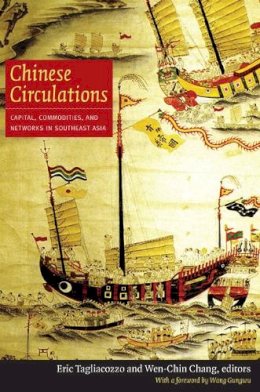18%OFF
Stock image for illustration purposes only - book cover, edition or condition may vary.
Chinese Circulations
Tagliacozzo
FREE Delivery in Ireland
Product Details
Place of Publication
North Carolina, United States
Shipping Time
Usually ships in 7 to 11 working days
About Tagliacozzo
Eric Tagliacozzo is Associate Professor of History at Cornell University. He is the author of Secret Trades, Porous Borders: Smuggling and States Along a Southeast Asian Frontier and co-editor of The Indonesia Reader: History, Culture, Politics, also published by Duke University Press. Wen-Chin Chang is an Associate Research Fellow at the Center for Asia-Pacific Area Studies at the Academia ... Read moreSinica in Taiwan. Show Less
Reviews for Chinese Circulations
“Collectively, the chapters provide a longue durée view of how Chinese circulations have historically shaped the economic landscape and buoyancy of the Southeast Asia region. By tracking disparate flows of actors, objects, ideas, and practices, the authors show how the kinship-based commercial capitalism originating in China cumulatively created conditions for meeting the challenges of European industrial capitalism and, more recently, ... Read morecontemporary globalization.”—Aihwa Ong, author of Flexible Citizenship: The Cultural Logics of Transnationality and co-editor of Ungrounded Empires: The Cultural Politics of Modern Chinese Transnationalism “Focused exclusively on Chinese commodity trades in Southeast Asia, Chinese Circulations is a pioneering investigation of an important region.”—Peter C. Perdue, author of China Marches West: The Qing Conquest of Central Eurasia “The authors have used their great professional skills to paint a picture of extensive and precarious trading activity that illuminates the underpinnings of Southeast Asian economic development for the last millennium. It is their success in doing so that recommends this collection to all who wish to understand why the region is what it is today.”—Wang Gungwu, from the foreword “On the whole, this well-written book will be an important reference not only to those who are interested in Sino-Southeast Asian studies, but will also attract readers exploring the historical development of globalization, particularly from the perspective of how commodity, information, capital and human beings have been circulating and intertwining together for many centuries. Moreover, I am confident that this book will have particular value given the increased interest in studying China’s rise at present, on the basis of enormous amounts of exported commodities and millions of emigrants, which has affected and will further affect Southeast Asia and the wider world.”
Li Minghuan
Asian Anthropology
“This collection of essays offers the most comprehensive and updated examination of the flow of commodities, capital, and people between China and Southeast Asia…. [W]ith unmatched breadth and depth, [it] sheds new light on the dynamic and complex trade relations between China and Southeast Asia.”
Hongshan Li
The Historian
“This is a substantive volume ... that, in the best revisionist tradition, forces historians, anthropologists, sociologists, economists, and others to reevaluate the power, influence, and dominance of local Southeast Asian agencies against the earlier proposals of Chinese and Western predominance of overseas and regional trade after 1600. ... [T]his book should be mandatory reading among scholars and graduate students who specialize in the diverse aspects of Southeast Asian, Chinese, and colonial-era history, and also those who variously study diasporas, servitude, immigration, and economic, maritime, and borderlands topics. As noted above, the book has great importance in its potential to allow scholars and diplomats to draw on the past to envision China’s future relationships within Asia and beyond.”
Kenneth R. Hall
China Review International
“[T]his book is a relevant and valuable read for scholars and advanced students of not only Chinese and Southeast Asian studies, but also of global, economic, environmental, diaspora and socio-political histories. By combining the usually disparate sub-fields of Southeast Asian studies–the wide range of Asian and European languages alone required to tackle primary sources renders any kind of regional expertise near impossible–and linking them with the twisted strands of Chinese commercial activity, this volume is reminiscent of Silk Road studies in its scope and richness. The multi-dimensional, diverse, yet mutually informed perspectives offered by this book are perhaps its most significant contribution, and this is precisely what an edited volume such as this is supposed to achieve.”
Karen M. Teoh
Journal of International and Global Studies
“[The] essays . . . form a composite picture of the China trade and its effects on Southeast Asian societies that covers a wide swathe of the past and throws light on present relations. . . . This high-quality collection widens the understanding of Southeast Asia and reminds us of the weakness of the nation-state approach by being willing to transcend (or ignore) state borders, Skinnerian macroregions, or ethnic boundaries. . . .”
Mary Somers Heidhues
Asian Studies Review
“Once in a while some groundbreaking efforts on regional studies are carried out to cheer the hearts of the specialists and general readers. Chinese Circulations falls into this mould and contributes significantly to the unraveling of the multifaceted maritime and overland trade and exchanges between China and Southeast Asia during the past few centuries.”
Voon Phin Keong
China Review
“This impressive collection of research papers is a major contribution to recent efforts to break down a dysfunctional barrier between the study of the history of China and that of the history of Southeast Asia….So we have here an excellent big volume that gives much food for thought and that contributes very substantially to our understanding of the multiple circulations of people and commodities that made the early modern world.”
John E. Wills Jr.
Journal of Economic History
Show Less


